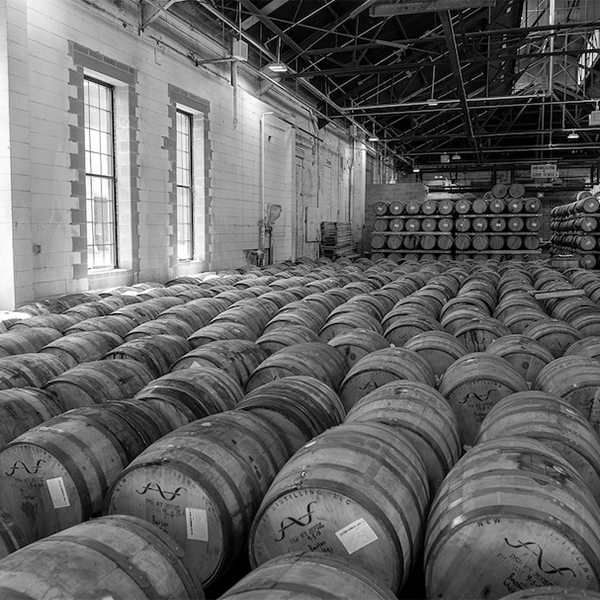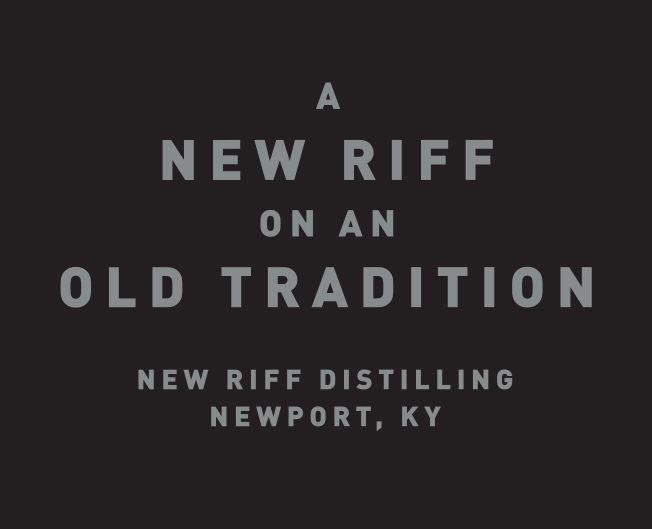The United States Bourbon industry has experienced incredible growth in the past decade. Today, there are many producers and recipes to choose from with a wide range of flavors to taste, all made from at least 51% corn.
However, there are a lot of misconceptions in regards to Bourbon aging. We want to cover a few basic facts and old traditions when making Bourbon.
At New Riff, we use full-size, 53-gallon new charred oak barrels, similar to other Bourbon distilleries in the Kentucky industry. Our barrels are aged beyond two years—in fact, all New Riff whiskey is aged for at least four years—for whiskey maturity. But behind the age statement, there’s more than meets the eye.
Kentucky Bourbon Aging Explained
Whiskey drinkers love Bourbon because of its complex, sweet flavors. Where do these flavors come from?
Under federal standards, Kentucky Bourbon must be aged in new charred oak barrels for aging at no greater than 125 proof (62.5% alcohol-by-volume) during the distillation process and must be made of at least 51% corn. Straight Bourbon must be aged for at least two years. The distillate – the Bourbon after it has been distilled, but before it has entered the barrel for aging – is clear in color. It also only contains the flavor of the grains where it was distilled.
Multiple distilleries offer unaged whiskey, but many suggest saving your money for the traditional process. Save your money because the barrel is where most of the Bourbon flavor comes from. What happens when straight Bourbon is aged in barrels? How can a beverage start with one taste, and change into something delicious by sitting in a new oak barrel?
Bourbon Barrels
The amount of malted barley in the mash bill is not the only element that gives Bourbon whiskey its distinct flavor. The barrel that the Bourbon is aged in imparts a lot of the flavor that we all know and love. Standard Bourbon barrels hold 53 gallons of Bourbon, and are mostly assembled by hand using new charred white oak. The barrels do not have to be 53 gallons, but this is the typical standard for many distillers. The “new” in the phrase means that these barrels have never been used before.

The majority of distilleries use the famous barrel manufacturer (called a cooperage), Independent Stave Company (ISC). At New Riff, we work with ISC as well as Kelvin Cooperage in Louisville to source toasted and charred oak barrels, including generous amounts of extra fine quality barrels made with extra air-dried oak staves. All of our whiskeys utilize a variety of specific barrel types and styles.
Bourbon goes into the barrel clear in color and flavored from the grain only. It gets all of its color, its woody and oaky flavors, as well as overall maturity of flavor, from these types of oak barrels. Once the barrels are used for Bourbon they are shipped from the United States to Scotland and many other countries to serve as “used” barrels by other spirits industries.
These used barrels are also a popular option for wineries and, especially, breweries. Since Kentucky straight Bourbon whiskey requires a new barrel every time, the barrels can’t be used for Bourbon a second time. Due to most of the flavor of the barrel going into the Bourbon, the barrel has less to contribute to the next spirit, and the aging time for Scotch in used barrels is longer.
From the beginning, New Riff sought to use a wide variety of new charred oak barrels from reputable cooperages, in an ongoing quest to find the best barrels for our whiskey. But we started out following the “Keep It Simple, Stupid” approach, and used a very basic, industry-standard barrel, which gave us a baseline to work with after a few years of aging Bourbon.
Only after that, can a distiller make wise choices about other barrel techniques. Today, we use 100% toasted oak, along with a few barrels using extra-air-drying on the staves. This matrix of barrels delivers a complex, comprehensive array of maturation influence upon all our whiskeys.
The Char
Just as not all whiskey is bourbon, not every barrel is a bourbon barrel. Every oak barrel must be charred on the inside before it can age Bourbon. An optional step is toasting, which brings additional layers of flavor. There are multiple charring levels, and the level varies depending on the distillery. A charred barrel gives Kentucky Bourbon that smoky flavor while adding sweetness and hints of toffee and vanilla notes.
These sweet notes that whiskey lovers crave come from the wood’s sugars that caramelize during the toasting process. Many distilleries—including New Riff—use a number 4 char, where flames are shot through a barrel for 55 seconds.
Distillate
Once the oak barrels are charred, they’re ready to be filled with the distillate. Many considerations must be made during this step of the Bourbon production process. Almost all distilleries use a barrel entry proof between 110 and 125 proof (55%-62.5% alcohol-by-volume). This range of distillate proof creates a balance of beneficial compound extraction, tannins, and color.
Barreling Proof
An important parameter of the barrel aging process is the proof of the whiskey when it goes into the barrel. Not all whiskey is appropriate to use. By law, the whiskey can enter the barrel at no more than 125 proof (62.5% alcohol-by-volume), and the big distilleries mostly choose this to save money on barrels.
At New Riff, we choose to barrel at a fairly low 110 proof (55% alcohol-by-volume). This is because a specific range of flavors is more water-soluble at a lower proof. Most of all, research has shown that a whiskey barreled at a lower proof may age more quickly and “show better younger” than a higher barreling proof. It costs us more in cooperage to mature our whiskey this way, but it delivers the flavors we want.
Aging Warehouse
After the distillate is added to the barrels, they are left to age and mature in Bourbon warehouses or a rick house. Many distilleries have multi-floor warehouses with many rick levels where Bourbon barrels sit to age. Bourbon barrels filled with the same whiskey can age for the same period in separate parts of the warehouse, which means that the result can taste drastically different.
So, How Long Is Bourbon Aged?
Bourbon whiskey has typically aged a minimum of two years, though most brands are aged at least four years and often longer than that.
The drastic change in flavor profile comes from how temperature affects the barrels. Typically, there is no temperature regulation in aging warehouses. During the winter months the barrels contract and then expand once the summer heat approaches. As a result, the barrels “breathe” Bourbon in and out, creating evaporation that distilleries call “Angel’s Share.” The name is given to the portion of Bourbon that is lost to evaporation as the spirit matures. Bourbon aged on the cooler, lower floors of the warehouse can taste quite different from the same Bourbon aged on the warmer, upper floors.
Bourbons must be aged in a barrel and do not continue to age in the bottle. A Bourbon bottled with an age statement of four years is always a four-year-old Bourbon, even if you keep it in your cabinet for years after that.
Why Do We Age Bourbon?
Bourbon ages to mellow the bite of the alcohol and to add flavor to the spirit. As the spirit rests in its barrel to age, flavors from the wood are drawn out, which makes the whiskey called Bourbon the celebrated elixir that it is.
Is An Older Age Always Better?
Older Bourbon isn’t necessarily better. While some aging is desirable to achieve the best flavor profile, too much aging can actually cause the Bourbon to lose flavor. A great distiller can find the sweet spot in the aging process where the youngest whiskey no longer has its sharp, unfinished taste but hasn’t succumbed to flavor loss from over-aging.
FAQs
- How long is Bourbon aged in barrels?
- Bourbon can be aged in barrels for as little as a few months or as long as a few decades. The best Bourbons are aged for at least a few years where they can mellow and absorb flavor.
- How long is too long to age Bourbon?
- Federal standards dictate that Bourbon cannot be aged for more than 25 years. Experts say that any Bourbon aged more than 15 years begins to lose flavor.
